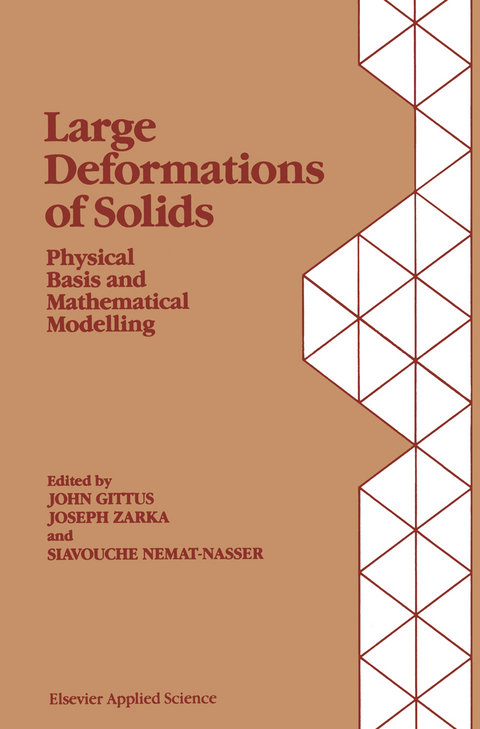
Large Deformations of Solids: Physical Basis and Mathematical Modelling
Springer (Verlag)
978-94-010-8023-1 (ISBN)
A central problemwhichhasbeensystematicallyattackedinthecaseofmetalsis the relationship between the behaviour of crystal defects such as dislocations and the deformationofa large specimenorengineering component.Itshould be possible to produce accurate predictionsof macroscopic deformation from a microscopic model and substantial progresstowardsthisendhasbeenmadeinrecentyears.Thefirsttwo sectionsofthe bookare largelyconcerned with progress in this very importantarea. A parallel theme which was established in earlier days is the developmentofcontinuummodelsfordeformation.Suchmodelswere proposedatatimewhenmicroscopyhadnotdevelopedtoitspresent levelofsophisticationsothat,forexample,itwasnotestablishedthat v VI PREFACE crystalsactuallycontaineddislocations.Thecontinuumtheorieswhich datebackmorethanacenturysoughttoexplainmicroscopicdeforma- tion in terms of abstract models involving mechanical elements of whichthespringand the dashpot wereprominentexamples.
Froma strictly practical standpoint these continuum models still have great utilitytoday, particularlyinareaswhere the materialsaresocompli- cated that the preferred route, linking microscopic behaviour with macroscopicbehaviour, is notyet available. Section3ofthe book is concernedthereforewiththecontinuumpointofviewformetals.
Session I: General Concepts.- 1. Sur Quelques Concepts Fondamentaux de la Mécanique.- 2. The Statistical Basis of Polycrystal Plasticity.- 3. Modelling of Finite Deformations of Anisotropic Materials.- 4. Microlocal Aspects of Finite Deformations in the Light of Nonstandard Analysis.- Session II: Metals—Physical Point of View.- 5. Déformations Finies des Agrégats Métaux: Aspects Physiques et Métallurgiques.- 6. The Effect of Partial Reversibility of Dislocation Motion.- 7. Effective-cluster Simulation of Polycrystal Plasticity.- 8. Pseudoelasticity and Shape Memory.- 9. A Unified Elastic-Viscoplastic Theory with Large Deformations.- Session III: Metals—Continuum Point of View.- 10. Interaction between Physical Mechanisms and the Structure of Continuum Theories.- 11. Microstructure and Phenomenological Models for Metals.- 12. Study of the Constitutive Law for a Polycrystal and Analysis of Rate Boundary Value Problem in Finite Elastoplasticity.- 13. Thermodynamique et Viscoplasticité du Monocristal Métallique: Comparaison et Synthèse de Modèles à Variables Internes.- 14. Some Applications of the Self-consistent Scheme in the Field of Plasticity and Texture of Metallic Polycrystals.- 15. Fundamental Considerations in Micromechanical Modeling of Polycrystalline Metals at Finite Strain.- Session IV: Rocks and Composites.- 16. Generalization of the Mandel—Spencer Double-Slip Model.- 17. On the Structure of Single Slip and its Implications for Inelasticity.- 18. Kinematics in Plastically Deformed Rocks.- 19. A Theory for Coupled Stress and Fluid Flow Analysis in Jointed Rock Masses.- Session V: Soils.- 20. L’Effet de la Formation des Surfaces de Glissement dans les Milieux Continus.- 21. On Large Deformations of Rock-type Transversely Isotropic Materials.-22. Physical Bases for the Thermo-Hygro-Rheological Behaviours of Wood in Finite Deformations.- 23. Bifurcation par Localisation de la Déformation: Etude Expérimentale et Theorique à L’Essai Biaxial sur Sable.- 24. A Mechanical Description of Saturated Soils.- 25. Some Macroscopic Consequences of the Granular Structure of Sand.
| Zusatzinfo | 502 p. |
|---|---|
| Verlagsort | Dordrecht |
| Sprache | englisch |
| Maße | 152 x 229 mm |
| Themenwelt | Technik ► Maschinenbau |
| ISBN-10 | 94-010-8023-2 / 9401080232 |
| ISBN-13 | 978-94-010-8023-1 / 9789401080231 |
| Zustand | Neuware |
| Haben Sie eine Frage zum Produkt? |
aus dem Bereich


